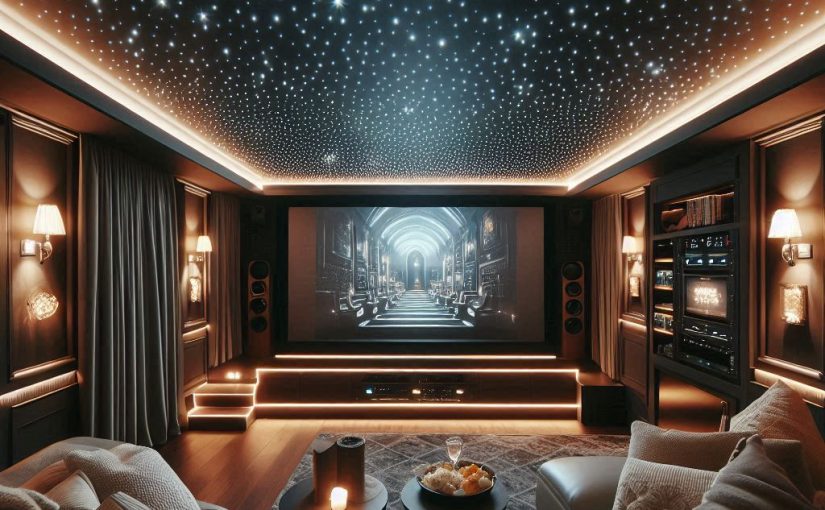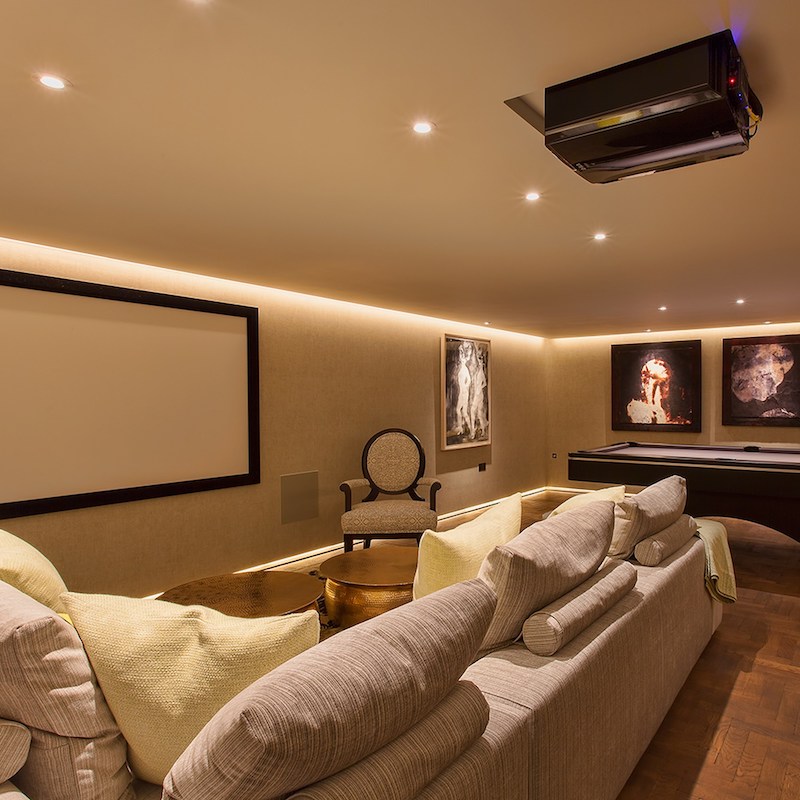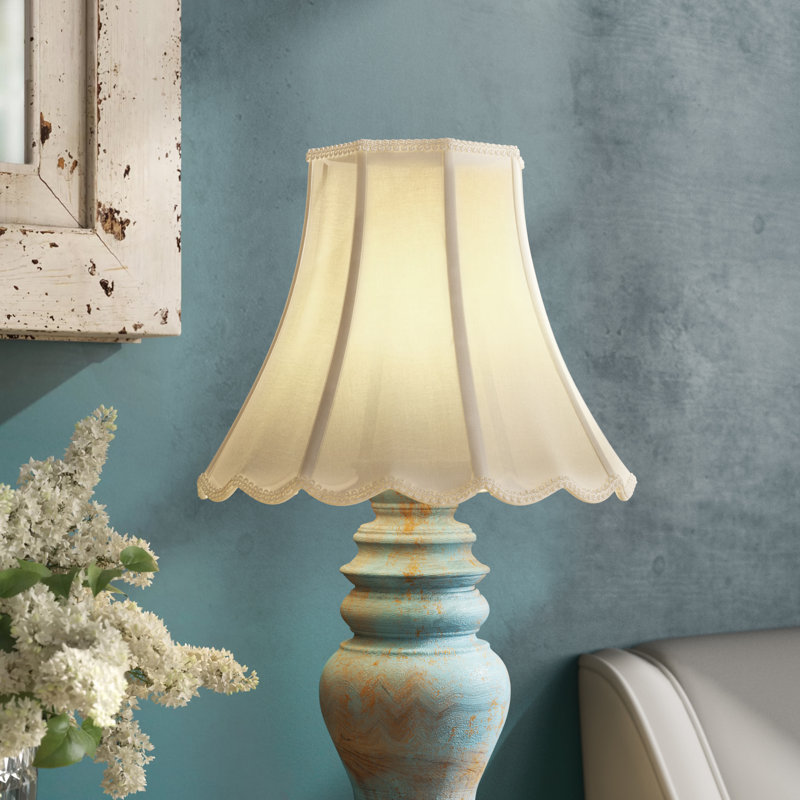Key Components of Home Theater Lighting
Creating the right ambiance in a home theater is essential for a true cinematic experience. Proper lighting plays a pivotal role in enhancing the visual quality and comfort of the space. Here, we will explore the critical components that form the foundation of effective home theater lighting.
Types of Lighting Fixtures Used in Home Theaters
In home theaters, lighting choices are critical to both functionality and style. Various types of lighting fixtures are commonly used:
- Recessed Lighting: These fixtures are installed into the ceiling, giving a clean, streamlined look. They are great for general lighting and can be dimmed to suit different moods and purposes.
- Sconces: Wall sconces provide soft, ambient lighting that enhances the theater’s overall aesthetic without overwhelming the space.
- LED Strip Lights: These offer versatility and can be used for cove lighting or under seating for a dramatic effect. They’re energy-efficient and available in various colors.
- Track Lighting: This option allows for directional lighting which can be adjusted to highlight posters or walkways.
- Table and Floor Lamps: For a more traditional look or in multi-use spaces, these lamps add a decorative element and additional light control.
Importance of Task Lighting in Home Theaters
Task lighting is essential in home theaters not just for aesthetics, but for functionality. It ensures that small tasks, such as reading or using a remote control, can be performed without having to light up the entire room. This lighting typically includes:
- Adjustable Floor Lamps: Positioned strategically, they can provide just enough light without interfering with the image quality.
- Cabinet Lighting: In home theaters with storage or display cases, these lights help in finding items quickly.
- Step Lighting: Safety should never be compromised. Illuminated steps are essential to prevent trips and falls in the dim environment of a theater.
Effective home theater lighting involves a blend of different fixture types and careful consideration of where task lighting is crucial. Together, they create not only a functional viewing space but also an inviting atmosphere perfect for entertaining.
Designing Your Home Theater Lighting
When designing your home theater’s lighting, it is essential to consider both function and aesthetics. Properly structured lighting not only improves the visual appeal but also enhances safety and functionality of the space.
Incorporating Safety and Step Lighting
Safety is paramount in a home theater setup. Incorporate lighting into steps and pathways to prevent accidents. Options like low-level LED strips or small wall-mounted lights ensure visibility without distracting from the movie experience. Properly illuminated steps help guests navigate comfortably and securely in the dimly lit environment.
Using Accent and Ambient Lighting to Enhance Atmosphere
Accent and ambient lighting play crucial roles in creating the right atmosphere. Accent lighting helps highlight architectural features or movie posters, adding depth to the room. Ambient lighting provides a soft glow, enhancing the overall comfort and aesthetic without affecting the screen visibility. Utilizing dimmable LED strips or recessed lighting can produce an immersive experience that mimics a commercial cinema.
Specialist Lighting Features Like Starfield and Cove Lighting
For those looking to bring a unique flair to their home theater, specialist lighting features like starfield or cove lighting are excellent choices. Starfield lighting uses fiber optics to mimic a night sky, adding a magical element to the ceiling. Cove lighting, installed in ceiling recesses, offers gentle illumination that can transform the space’s ambiance. Both options provide customizability and can enhance the thematic elements of the theater room.
Planning and Installing Home Theater Lighting
Electrical and Control Considerations for Lighting
When planning home theater lighting, electrical setup is crucial. Ensure your lighting circuits are separate from those used for your audio-visual equipment. This separation prevents electrical noise from interfering with your sound system. Consider installing smart dimmers and controllers. These devices allow you to adjust lighting levels conveniently, often via a remote or smartphone app. They also enable automatic adjustments based on the movie’s play status – brightening when paused and dimming when playing.
Tips on Positioning and Installing Different Light Fixtures
Proper positioning of light fixtures enhances both safety and ambiance. Place recessed lighting in the ceiling to ensure even general lighting. Install task lighting near seating areas for functionality without disrupting the viewing experience. Use accent lighting to highlight theater decor and step lighting for visibility on stairs. For a dramatic effect, install cove lighting around the room’s perimeter or starfield lighting in the ceiling. Always aim to keep light fixtures from shining directly onto the screen to avoid glare.
Technological Advances in Home Theater Lighting
The field of home theater lighting has seen significant technological advancements. These innovations enhance both the functionality and aesthetic appeal of home theaters.
Smart Lighting Controls and Systems
Smart lighting controls are revolutionizing home theater experiences. Such systems allow users to adjust lighting with just a few clicks on a smartphone or a remote. You can dim lights, change colors, and even set lighting scenes that mimic commercial cinemas. Advanced systems integrate with home automation, offering seamless control over the environment.
Innovations in LED and Fiber Optic Technologies
Recent advancements in LED technology offer more energy-efficient solutions with a broader color spectrum. Fiber optic lighting, particularly in starfield lighting, creates an enchanting ‘night sky’ effect right on your ceiling. These technologies are not just about illumination; they transform your home theater into a dynamic and interactive space. LEDs and fiber optics are versatile, durable, and provide superior light quality that can enhance your movie-watching experience.
Common Challenges in Home Theater Lighting Design
Achieving the perfect home theater lighting setup can be tricky. There are several challenges you might face.
Managing Light Reflection and Spillage
To prevent glare on your screen, consider these tips:
- Use matte finishes around the screen to reduce reflections.
- Position lights so they don’t shine directly on the screen.
- Install blackout curtains to eliminate external light.
This approach ensures a clear, distraction-free picture.
Balancing Aesthetics with Functionality
Blending style and practicality can be challenging. Here’s how you can balance them:
- Select lighting fixtures that complement your theater’s theme.
- Use dimmable lights to adjust for different occasions.
- Integrate smart lighting to easily switch between settings.
By considering both looks and usability, you create a home theater that dazzles and delivers.
Additional Tips for Perfect Home Theater Lighting
Creating the perfect home theater lighting setup requires more than just installing lights. These additional tips, focusing on the color and intensity of lights and their integration with home theater design elements, can help you achieve the ideal ambiance and functionality for your space.
Choosing the Right Color and Intensity of Lights
Color and intensity have a significant impact on a home theater’s mood. When selecting lights, consider these aspects:
- Choose Warm Colors: Warm colors like reds, oranges, or yellows create a cozy atmosphere. They mimic the glow of theater curtains and add a classic touch.
- Adjustable Intensity: Lights that can dim allow for changing the room’s brightness to fit the occasion. Brightness should be just enough to move around safely but low enough not to wash out the screen.
- Avoid Blue Light: Blue light is energizing but can interfere with the movie-watching experience. Stick with softer colors to promote relaxation.
Color and intensity can make or break the viewing experience. Warm, dimmable lights are best for maintaining focus on the screen.
Integrating Lighting with Home Theater Design Elements
When integrating lighting, harmony with the theater’s design is key. Aim for these outcomes:
- Seamless Integration: Lights should blend with the walls, ceilings, and furniture. Recessed lighting or strip lighting can offer a built-in look.
- Complement the Theme: Select lighting fixtures that match your theater’s theme. For a sci-fi theme, consider modern LED strips. For a classic theater feel, wall sconces might be ideal.
- Highlight Decor: Use accent lighting to illuminate posters or memorabilia without spilling light onto the screen.
Lighting should work with other theater elements to enhance the experience. Aim for balanced lighting that complements the room’s theme and decor.









